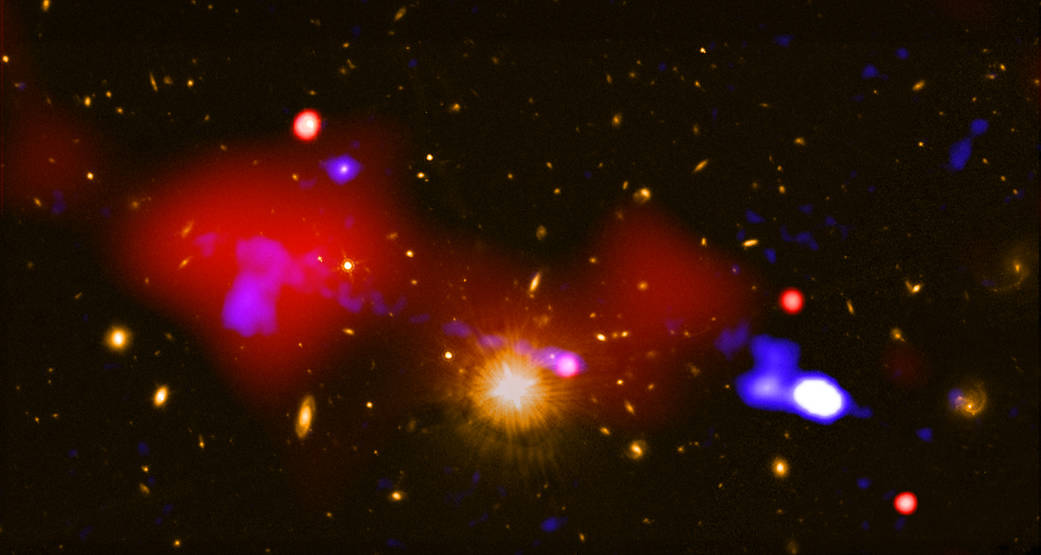黑洞孕育着百万光年之外的新星
Black holes are famous for ripping objects apart, including stars. But now, astronomers have uncovered a black hole that may have sparked the births of stars over a mind-boggling distance, and across multiple galaxies.
If confirmed, this discovery, made with NASA’s Chandra X-ray Observatory and other telescopes, would represent the widest reach ever seen for a black hole acting as a stellar kick-starter. The black hole seems to have enhanced star formation more than one million light-years away. (One light year is equal to 6 trillion miles.)
“This is the first time we’ve seen a single black hole boost star birth in more than one galaxy at a time,” said Roberto Gilli of the National Institute of Astrophysics (INAF) in Bologna, Italy, lead author of the study describing the discovery. “It’s amazing to think one galaxy’s black hole can have a say in what happens in other galaxies millions of trillions of miles away.”
A black hole is an extremely dense object from which no light can escape. The black hole’s immense gravity pulls in surrounding gas and dust, but particles from a small amount of that material can also get catapulted away instead at nearly the speed of light. These fast-moving particles form two narrow beams or “jets” near the poles of the black hole.
The supermassive black hole scientists observed in the new study is located in the center of a galaxy about 9.9 billion light-years from Earth. This galaxy has at least seven neighboring galaxies, according to observations with the European Southern Observatory’s Very Large Telescope (VLT) and the Large Binocular Telescope (LBT).
Using the National Science Foundation’s Karl Jansky Very Large Array, scientists had previously detected radio-wave emission from a jet of high-energy particles that is about a million light-years long. The jet can be traced back to the supermassive black hole, which Chandra detected as a powerful source of X-rays produced by hot gas swirling around the black hole. Gilli and colleagues also detected a diffuse cloud of X-ray emission surrounding one end of the radio jet. This X-ray emission is most likely from a gigantic bubble of hot gas heated by the interaction of the energetic particles in the radio jet with surrounding matter.
As the hot bubble expanded and swept through four neighboring galaxies, it could have created a shock wave that compressed cool gas in the galaxies, causing stars to form. All four galaxies are approximately the same distance, about 400,000 light years, from the center of the bubble. The authors estimate that the star formation rate is between about two to five times higher than typical galaxies with similar masses and distance from Earth.
“The story of King Midas talks of his magic touch that can turn metal into gold,” said co-author Marco Mignoli, also of INAF in Bologna, Italy. “Here we have a case of a black hole that helped turn gas into stars, and its reach is intergalactic.”
Astronomers have seen many cases where a black hole affects its surroundings through “negative feedback” – in other words, curtailing the formation of new stars. This can occur when the black hole’s jets inject so much energy into the hot gas of a galaxy, or galaxy cluster, that the gas can’t cool down enough to make large numbers of stars.
In this newly discovered collection of galaxies, astronomers have found a less common example of “positive feedback,” where the black hole’s effects increase star formation. Moreover, when astronomers previously encountered positive feedback, it either involved increases in the star formation rate of 30% or less, or it occurred over scales of only about 20,000 to 50,000 light years on a nearby companion galaxy. Whether the feedback is positive or negative depends on a delicate balance between the heating rate and cooling rate of a cloud. That is because clouds that are initially cooler when hit by a shock wave are more prone to experience positive feedback, and form more stars.
“Black holes have a well-earned reputation for being powerful and deadly, but not always,” said co-author Alessandro Peca, formerly at INAF in Bologna and now a Ph.D. student at the University of Miami. “This is a prime example that they sometimes defy that stereotype and can be nurturing instead.”
The researchers used a total of six days of Chandra observing time spread out over five months.
“It’s only because of this very deep observation that we saw the hot gas bubble produced by the black hole,” said co-author Colin Norman of the Johns Hopkins University in Baltimore, Maryland. “By targeting objects similar to this one, we may discover that positive feedback is very common in the formation of groups and clusters of galaxies.”
A paper describing these results has been published in the most recent issue of the journal “Astronomy and Astrophysics” and is available online.
NASA’s Marshall Space Flight Center manages the Chandra program. The Smithsonian Astrophysical Observatory’s Chandra X-ray Center controls science and flight operations from Cambridge and Burlington, Massachusetts.
Image credit: X-ray: NASA/CXC/INAF/R. Gilli et al.; Radio NRAO/VLA; Optical: NASA/STScI
Read more from NASA’s Chandra X-ray Observatory.
For more Chandra images, multimedia and related materials, visit:
黑洞以撕裂物体而闻名,包括恒星。但是现在,天文学家们发现了一个黑洞,它可能在一个令人难以置信的距离内,跨越多个星系,引发了恒星的诞生。
如果得到证实,这一由美国国家航空航天局钱德拉X射线天文台和其他望远镜完成的发现,将是迄今为止黑洞作为恒星启动器所能达到的最大范围。黑洞似乎增强了100万光年以外的恒星形成。(一光年等于6万亿英里。)
位于意大利博洛尼亚的国家天体物理研究所(INAF)的罗伯特吉利说:“这是我们第一次看到一个黑洞同时在多个星系中促进恒星的诞生。”“想到一个星系的黑洞可以对数百万亿英里外的其他星系的情况有发言权,这真是太神奇了。”
黑洞是一种密度极高的物体,光线无法从中逃逸。黑洞巨大的引力吸引着周围的气体和尘埃,但一小部分物质中的粒子也会以接近光速的速度被弹射出去。这些快速移动的粒子在黑洞的两极附近形成两束窄束或“喷流”。
科学家们在新研究中观测到的超大质量黑洞位于距离地球99亿光年的星系中心。根据欧洲南方天文台(European Southern Observatory)的甚大望远镜(VLT)和大型双目望远镜(LBT)的观测,这个星系至少有七个邻近的星系。
利用美国国家科学基金会(National Science Foundation)的卡尔·扬斯基超大阵列(Karl Jansky Very Large Array),科学家们此前曾探测到大约100万光年长的高能粒子射流发射出的无线电波。这个喷流可以追溯到超大质量黑洞,钱德拉探测到它是由围绕黑洞旋转的热气体产生的强大x射线源。吉利和他的同事们还在射电射流的一端周围探测到了一团弥散的x射线辐射云。这种x射线辐射极有可能是由于射电射流中的高能粒子与周围物质相互作用而产生的巨大热气泡。
当热气泡膨胀并扫过四个邻近的星系时,可能会产生冲击波,压缩星系中的冷气体,导致恒星形成。这四个星系距离气泡中心的距离大约是40万光年。作者估计,恒星形成速率比质量和距地球距离相近的典型星系高约2至5倍。
“迈达斯国王的故事讲述了他的点石成金的魔力,”同样来自意大利博洛尼亚INAF的合著者马可·米尼亚利说。“这里我们有一个黑洞的例子,它帮助气体变成恒星,它的范围是星系间的。”
天文学家已经看到许多情况,黑洞会通过“负反馈”影响周围环境,换句话说,就是减少了新恒星的形成。当黑洞的喷流向星系或星系团的炽热气体中注入大量能量,以致气体无法冷却到足以形成大量恒星时,就会发生这种情况。
在这个新发现的星系群中,天文学家发现了一个不太常见的“正反馈”例子,即黑洞的影响增加了恒星的形成。此外,当天文学家以前遇到正反馈时,它要么涉及到恒星形成率增加30%或更少,要么发生在一个2万到5万光年范围内的邻近伴星星系。反馈是正还是负取决于云的加热速率和冷却速率之间的微妙平衡。这是因为当受到冲击波冲击时,最初温度较低的云更容易得到正反馈,从而形成更多的恒星。
“黑洞以其强大和致命而著称,但并非总是如此”。亚历山德罗·佩卡曾在博洛尼亚的INAF工作,现在是迈阿密大学的博士生说,“这是一个很好的例子,他们有时会违抗陈规定型观念,反而可能会养育他们的典型例子。”
研究人员总共使用了六天的钱德拉观察时间,这些时间分布在五个月内。
“正是由于这一非常深入的观察,我们才看到了黑洞产生的热气泡。”来自马里兰州巴尔的摩市约翰·霍普金斯大学的共同作者科林·诺曼说,“通过瞄准类似的目标,我们可能会发现,在星系群和星系团的形成过程中,正反馈非常普遍。”
描述这些结果的论文已发表在最新一期的《天文学与天体物理学》杂志上,并可在线获取。
NASA的马歇尔太空飞行中心负责管理钱德拉项目。史密森天体物理天文台的钱德拉X射线中心控制着来自马萨诸塞州剑桥和伯灵顿的科学和飞行业务。
图片来源: X-ray: NASA/CXC/INAF/R. Gilli et al.; Radio NRAO/VLA; Optical: NASA/STScI
欲了解更多钱德拉图像、多媒体和相关材料,请访问:

